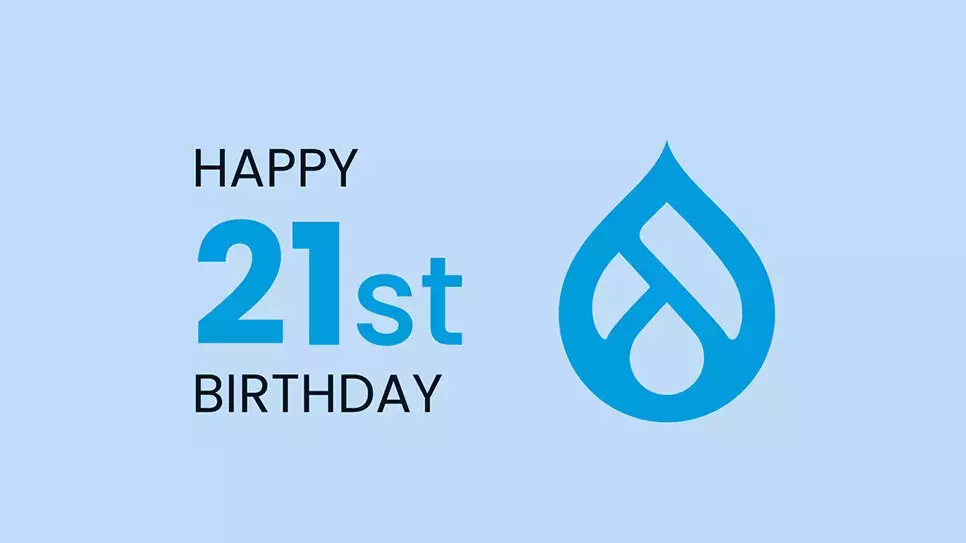Subscribe To Our NewsLetter
Share This Post:
First of all, happy twenty first birthday to Drupal. Yes, you heard that right. It is Drupal’s 21st birthday! Two decades ago, an idea was conceptualized to improve the cost efficiency of an internet connection by sharing it among a group of friends. That idea has now turned out to be one of the biggest open source projects in the entire world!
Celebrating two decades of Drupal!
The celebrations did not stop ever since the launch of Drupal 9 in 2020 (Well, the vibrant Drupal community members never stop celebrating Drupal and always find a reason to celebrate.)
2021 marked the 20th birthday of Drupal. Twenty years of existence and growing! This was a reason big enough for celebration. Drupal is among those few open source software’s filled with a vibrant, expanding community and its members are prone to innovation. This has made the CMS functional even in the face of the latest technology. Learn about web development trends in 2021 along with macro trends for 2021 and see how Drupal keeps up with them.
Drupal’s Growth Over the Years!
Let’s look back at how Drupal has evolved organically in the past two decades to become a sustainable community over the years, one that holds immense capacity to keep thriving despite all odds.
Drupal 1.0
Drupal 1.0 was introduced as an open-source initiative, drop.org, in 2001. Dries based it off Slash, a modular CMS that was the first version having 18 modules to use. There was also no restriction in who could contribute to the software.

Isn’t it substantial, how far we’ve come?
Drupal 2.0
When Drupal was updated, Drupal 2.0 promised an option to translate or modify their website in the language of another. This was a significant step in expanding, but also brought people together as members of the Drupal community. Other improvements included user reviews as well as a user permissions system. sections for stories as well as user groups.
Drupal 3 and 4
With the release of Drupal’s third major edition nodes became the primary element of content in Drupal as opposed to websites, nodes offered the flexibility that was needed within this Content Management System. Each category of content – whether it was an article, news report or forum – was designed as an element and then handled by a node module. So, Drupal was made more user-friendly to use by everyone.
Drupal 4.0 was noteworthy due to its ability to experience an unprecedented growth rate it was armed with an online-shop module included in Drupal 4.4 as well as a WYSIWYG (What you see is the What you Get) editor the fourth edition of Drupal made all its possibilities open. Web writers with no programming background can now utilize Drupal as well, which is why there was the following increase in use following the release of the fourth and complete version.
After its success The first ever Drupal Conference was held in Belgium in 2005. Here’s Dries Buytaert’s ID from that conference:

This is how Drupal started taking hold in the global community, with people from all over the nation, across the globe using and contributing to it.
Drupal 5
Drupal 5.0 was released six years ago. The number of modules contributed had increased to 2500, and the number of contributors was now 492 Version 5.0 made web development easier by including jQuery, which is a JavaScript library that makes HTML much simpler. For faster site development, Version 5.0 included pre-created but customization Drupal packages as well as improved CSS (Cascading Style sheets) management.
Drupal 6
The sixth version of Drupal saw a site-wide growth and expansion – 7000 contributed modules were already in place in addition to 34 core modules and 600 custom themes. Drupal 6.0 added great features like a rewritten menu structure, a ton of drag-and-drop features, even better security etc
Drupal 7 and 8
Drupal 8 and 7 introduced personalisation and customization to the digital world, and Drupal adapted accordingly. Drupal 7 offered URL handling, integration to e-commerce and custom fields that could easily be used across different content types and users. Using installation profiles, companies could now systematically distribute their website.
Below is the snapshot of Drupal 7.
Drupal 8 was the first Drupal to embrace personalisation and respond to user needs. It added 200 key features to its website, including adaptability to different devices. Businesses began to focus more on user experience and personalized feeds and suggestions were also introduced.
Drupal 9
Drupal 9 was dubbed the “easiest upgrade for a decade” by Drupal. It launched in the middle of a pandemic, which began shortly after Drupal’s nineteenth Birthday. To cater to the needs and wants of the global user base that had been affected by it. Drupal 9 updated third-party dependencies and removed obsolete code to create digital solutions that are compatible with most individuals and businesses. Get all the answers to your questions about Drupal 9.
Drupal 10
Drupal 10 will be released in 2022 and includes many new features and enhancements!
LN Webworks Pvt. Ltd. and Team Loves Drupal!
We at LN Webworks Pvt. Ltd. have been using Drupal since it’s inception and loving since then. The support of widespread community, minimum learning curve and customizable components are some of the facets about Drupal that are developers especially fond of.
Share This Post:
Author Information

LN Webworks
Your Drupal Solution PartnerLN Webworks have championed open-source technologies for nearly a decade, bringing advanced engineering capabilities and agile practices to some of the biggest names across media, entertainment, education, travel, hospitality, telecommunications and other industries.
